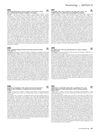extract, clone, and reinsert your own hair cells
signaling protein that, when suppressed, may grow hair by reducing inflammation and stem cell loss
natural substance from Neem tree with medicinal and pesticidal properties
an anticonvulsant repurposed for hair loss via histone inhibition


